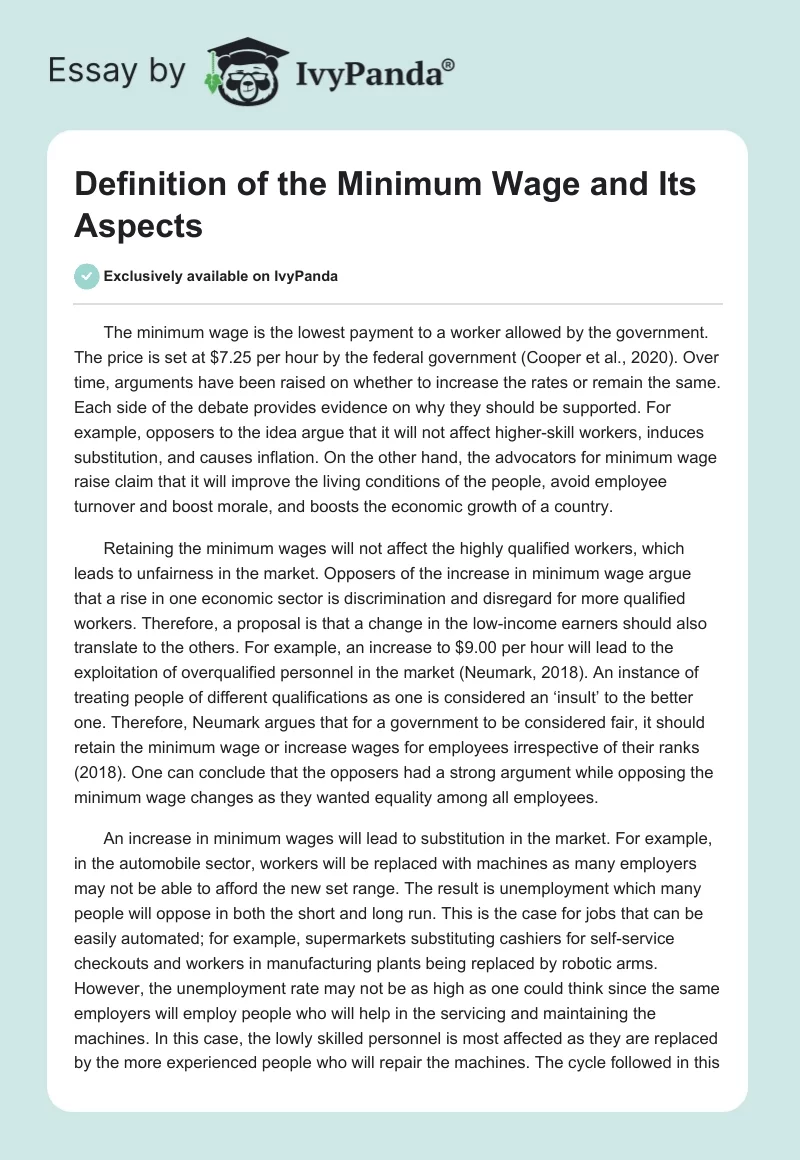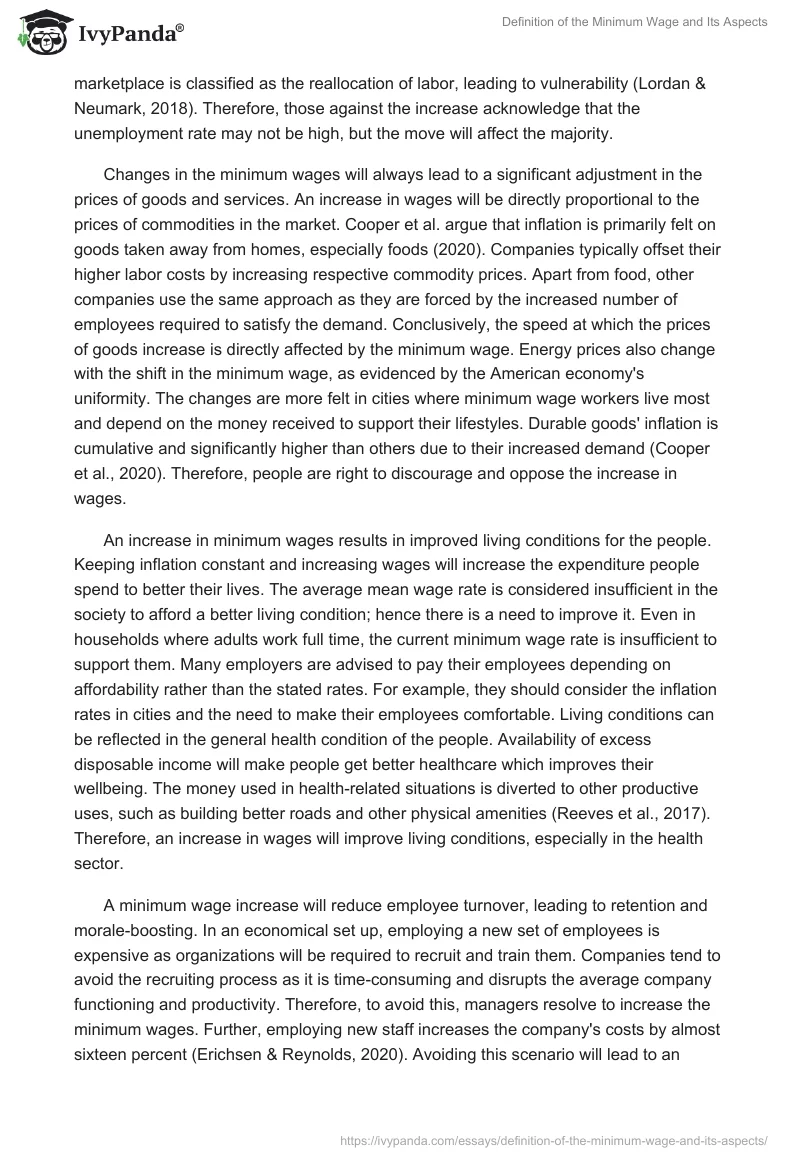The minimum wage is the lowest payment to a worker allowed by the government. The price is set at $7.25 per hour by the federal government (Cooper et al., 2020). Over time, arguments have been raised on whether to increase the rates or remain the same. Each side of the debate provides evidence on why they should be supported. For example, opposers to the idea argue that it will not affect higher-skill workers, induces substitution, and causes inflation. On the other hand, the advocators for minimum wage raise claim that it will improve the living conditions of the people, avoid employee turnover and boost morale, and boosts the economic growth of a country.
Retaining the minimum wages will not affect the highly qualified workers, which leads to unfairness in the market. Opposers of the increase in minimum wage argue that a rise in one economic sector is discrimination and disregard for more qualified workers. Therefore, a proposal is that a change in the low-income earners should also translate to the others. For example, an increase to $9.00 per hour will lead to the exploitation of overqualified personnel in the market (Neumark, 2018). An instance of treating people of different qualifications as one is considered an ‘insult’ to the better one. Therefore, Neumark argues that for a government to be considered fair, it should retain the minimum wage or increase wages for employees irrespective of their ranks (2018). One can conclude that the opposers had a strong argument while opposing the minimum wage changes as they wanted equality among all employees.
An increase in minimum wages will lead to substitution in the market. For example, in the automobile sector, workers will be replaced with machines as many employers may not be able to afford the new set range. The result is unemployment which many people will oppose in both the short and long run. This is the case for jobs that can be easily automated; for example, supermarkets substituting cashiers for self-service checkouts and workers in manufacturing plants being replaced by robotic arms. However, the unemployment rate may not be as high as one could think since the same employers will employ people who will help in the servicing and maintaining the machines. In this case, the lowly skilled personnel is most affected as they are replaced by the more experienced people who will repair the machines. The cycle followed in this marketplace is classified as the reallocation of labor, leading to vulnerability (Lordan & Neumark, 2018). Therefore, those against the increase acknowledge that the unemployment rate may not be high, but the move will affect the majority.
Changes in the minimum wages will always lead to a significant adjustment in the prices of goods and services. An increase in wages will be directly proportional to the prices of commodities in the market. Cooper et al. argue that inflation is primarily felt on goods taken away from homes, especially foods (2020). Companies typically offset their higher labor costs by increasing respective commodity prices. Apart from food, other companies use the same approach as they are forced by the increased number of employees required to satisfy the demand. Conclusively, the speed at which the prices of goods increase is directly affected by the minimum wage. Energy prices also change with the shift in the minimum wage, as evidenced by the American economy’s uniformity. The changes are more felt in cities where minimum wage workers live most and depend on the money received to support their lifestyles. Durable goods’ inflation is cumulative and significantly higher than others due to their increased demand (Cooper et al., 2020). Therefore, people are right to discourage and oppose the increase in wages.
An increase in minimum wages results in improved living conditions for the people. Keeping inflation constant and increasing wages will increase the expenditure people spend to better their lives. The average mean wage rate is considered insufficient in the society to afford a better living condition; hence there is a need to improve it. Even in households where adults work full time, the current minimum wage rate is insufficient to support them. Many employers are advised to pay their employees depending on affordability rather than the stated rates. For example, they should consider the inflation rates in cities and the need to make their employees comfortable. Living conditions can be reflected in the general health condition of the people. Availability of excess disposable income will make people get better healthcare which improves their wellbeing. The money used in health-related situations is diverted to other productive uses, such as building better roads and other physical amenities (Reeves et al., 2017). Therefore, an increase in wages will improve living conditions, especially in the health sector.
A minimum wage increase will reduce employee turnover, leading to retention and morale-boosting. In an economical set up, employing a new set of employees is expensive as organizations will be required to recruit and train them. Companies tend to avoid the recruiting process as it is time-consuming and disrupts the average company functioning and productivity. Therefore, to avoid this, managers resolve to increase the minimum wages. Further, employing new staff increases the company’s costs by almost sixteen percent (Erichsen & Reynolds, 2020). Avoiding this scenario will lead to an increase in savings in turnover costs. Additionally, making employees comfortable by paying them well improves their morale, reflected in increased productivity. An employee paid a fair wage leads to better physical and mental health, reducing fatigue (Erichsen & Reynolds, 2020). Therefore, employers aiming to increase their turnover costs should increase their employee’s minimum wages.
The general economy of the country improves with an increase in minimum wages. Improving the economy of a country involves alleviating people from poverty. Minimum wage earners usually are classified as poor hence decreasing its rate will lead to the country’s development. Gindling argues that increasing disposable income in low-income earners will allow purchasing essential goods and services for survival. Theoretically, increasing money in poor people’s pockets lifts them from poverty. However, the relationship between minimum wages and workers’ employment levels is complex. In one argument, minimum wages affect workers selectively; hence not all workers will be alleviated out of poverty. Second, minimum wages can increase the worker’s income but not necessarily the poor household’s incomes (2018). Therefore, it is not conclusive that the increase will improve the general economy but alleviating poverty can be used to indicate growth.
Different arguments are presented on the need to either retain the minimum wages or increase them. Each party supports its point of view, making them valid and satisfying. For example, those advocating for an increase argue that it improves the country’s economy, reduces employee turnover, and improves employees’ living conditions. On the other hand, the opposers assert that it will lead to inflation, affect overqualified employees, and cause market substitution. Therefore, some conclusive research should be done on some of the factors discussed to ensure conclusive evidence is provided, for example, how the increase will lead to the general growth of the economy.
References
Cooper, D., Luengo‐Prado, M. J., & Parker, J. A. (2020). The local aggregate effects of minimum wage increases. Journal of Money, Credit and Banking, 52(1), 5-35.
Erichsen, K., & Reynolds, J. (2020). Public school accountability, workplace culture, and teacher morale.Social Science Research, 85, 102347.
Gindling, T. H. (2018). Does increasing the minimum wage reduce poverty in developing countries?. IZA World of Labor.
Lordan, G., & Neumark, D. (2018). People versus machines: The impact of minimum wages on automatable jobs.Labour Economics, 52, 40-53.
Neumark, D. (2018). Employment effects of minimum wages.IZA World of Labor.
Reeves, A., McKee, M., Mackenbach, J., Whitehead, M., & Stuckler, D. (2017). Introduction of a national minimum wage reduced depressive symptoms in low‐wage workers: a quasi‐natural experiment in the UK.Health economics, 26(5), 639-655.


